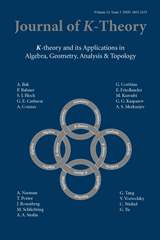Crossref Citations
This article has been cited by the following publications. This list is generated based on data provided by Crossref.
Peter, Tobias J.
2013.
Prime Ideals of Mixed Artin-Tate Motives.
Journal of K-Theory,
Vol. 11,
Issue. 2,
p.
331.
Biglari, Shahram
2013.
On lambda operations on mixed motives.
Journal of K-Theory,
Vol. 12,
Issue. 2,
p.
381.
Mazza, C.
and
Weibel, C.
2013.
Schur-finiteness in λ-rings.
Journal of Algebra,
Vol. 374,
Issue. ,
p.
66.


